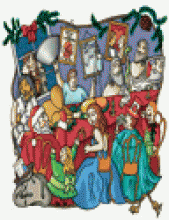We describe the unique case of a public figure who is well known for having delayed pubertal development and statural growth (Fig. 1). We believe we have discovered why Tintin, the young reporter whose stories were published between 1929 and 1975, never grew taller and never needed to shave.
Fig. 1: The patient and the research team (left to right): C.C. (33 years old, Tanner staging V), Tintin (60 years old [?], delayed development), L.O.C. (7 years old) and A.C. (5 years old).
We do not know Tintin's perinatal history. According to Hergé, the author of these stories, Tintin was 14 or 15 years old when he was created.1 He would, therefore, have been at least 60 years old during his final adventure with the Picaros.2 In that book, even though he had reached adulthood, Tintin has no beard or grey hair, and he exhibits no signs of pubertal development.
Recent literature has helped us gain a better understanding of the pathophysiology of hypopituitarism resulting from repeated head trauma.3 We believe that the multiple traumas Tintin sustained could be the first case of traumatic pituitary injury described in the literature.
Methods
We conducted an exhaustive assessment of this young reporter's stories in order to find incidents of significant neurotrauma. The first author (A.C., 5 years old) looked through all of the books along with the second author (L.O.C., 7 years old), who knows how to read and count higher than 10. A.C. was responsible for identifying pictures in which Tintin “tombait dans les pommes” (literally, “fell into the apples,” i.e., “lost consciousness”). This procedure had to be re-evaluated after 2 books because of the obvious lack of “apples” in Tintin's adventures. For each incident, we identified the cause of the trauma, the length of loss of consciousness (calculated by the number of frames before Tintin returns to normal activity) and the apparent severity of the trauma (indicated by the number of objects [e.g., stars, candles] revolving above Tintin's head). A Spearman correlation test was performed between the last 2 items.
Results
The research team (Fig. 1) successfully identified 50 significant losses of consciousness in 16 of Tintin's 23 books (see Table 1). Of these, 43 incidents involved head trauma with loss of consciousness representing grade 3 concussions. Tintin sustained 26 concussions resulting from a blow with a blunt object. The most frequently used object was a club (8 times). Other causes for the subject's loss of consciousness included bullet injury (3), chloroform poisoning (3), explosions (4), car accidents (3) and falls (2).
Table 1.
The mean length of loss of consciousness was 7.5 frames, and 7.5 objects, on average, revolved above his head during the impact. There was no statistically significant relation between these 2 elements of data (p = 0.42).
At no point in the books did the subject shave, grow taller or exhibit signs of pubertal development. Unfortunately, no brain imaging was performed. Also, the subject experienced loss of consciousness after “mild” dehydration,4 which could be an indirect sign of secondary adrenal insufficiency. This could be due to panhypopituitarism.
Conclusion
We hypothesize that Tintin has growth hormone deficiency and hypogonadotropic hypogonadism from repeated trauma. This could explain his delayed statural growth, delayed onset of puberty and lack of libido.
We also believe that involving children in research (the first 2 authors) is possible and beneficial. As a result, A.C. learned to count to 10 with good interobserver reliability and now knows the meaning of the expression “tomber dans les pommes.”
The main limitation of our article is the lack of paraclinical confirmation of the diagnosis. But, according to the second author (L.O.C.), “That's alright.”
To conclude, it is difficult to determine accurately Tintin's age and level of physical and sexual development. He has the physique of a child, but his conduct suggests that of an adult. Throughout his adventures, he has no girlfriend or marriage plans to curtail his activities. His “neutrality” allows both children and adults around the world to identify with this hero, which probably explains his universal appeal after 75 years of public life.
Footnotes
-
Contributors: A.C and L.O.C. were actively involved in collecting data. C.C. wrote the article. The 3 authors reviewed the final version together. A.C and L.O.C. did not understand the following words: hypogonadism, panhypopituitarism, Spearman correlation and libido. C.C. explained to them that the words mean “no hair above the wee-wee because of a missing hormone,” “a part of the brain that is not working,” “a test to see if 2 things are connected” and “wanting to make love,” respectively. After a lengthy discussion about hair and “wee-wees” and the meaning of “making love,” the 3 authors gave their approval for publication.












